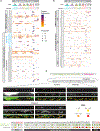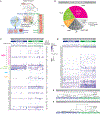A molecular atlas of adult C. elegans motor neurons reveals ancient diversity delineated by conserved transcription factor codes
- PMID: 38421866
- PMCID: PMC11091551
- DOI: 10.1016/j.celrep.2024.113857
A molecular atlas of adult C. elegans motor neurons reveals ancient diversity delineated by conserved transcription factor codes
Abstract
Motor neurons (MNs) constitute an ancient cell type targeted by multiple adult-onset diseases. It is therefore important to define the molecular makeup of adult MNs in animal models and extract organizing principles. Here, we generate a comprehensive molecular atlas of adult Caenorhabditis elegans MNs and a searchable database. Single-cell RNA sequencing of 13,200 cells reveals that ventral nerve cord MNs cluster into 29 molecularly distinct subclasses. Extending C. elegans Neuronal Gene Expression Map and Network (CeNGEN) findings, all MN subclasses are delineated by distinct expression codes of either neuropeptide or transcription factor gene families. Strikingly, combinatorial codes of homeodomain transcription factor genes succinctly delineate adult MN diversity in both C. elegans and mice. Further, molecularly defined MN subclasses in C. elegans display distinct patterns of connectivity. Hence, our study couples the connectivity map of the C. elegans motor circuit with a molecular atlas of its constituent MNs and uncovers organizing principles and conserved molecular codes of adult MN diversity.
Keywords: C. elegans; CP: Neuroscience; molecular diversity; motor neurons; mouse; neuropeptides; single-cell RNA sequencing; transcription factors.
Copyright © 2024 The Author(s). Published by Elsevier Inc. All rights reserved.
Conflict of interest statement
Declaration of interests The authors declare no competing interests.
Figures






Update of
-
A molecular atlas of adult C. elegans motor neurons reveals ancient diversity delineated by conserved transcription factor codes.bioRxiv [Preprint]. 2023 Aug 6:2023.08.04.552048. doi: 10.1101/2023.08.04.552048. bioRxiv. 2023. Update in: Cell Rep. 2024 Mar 26;43(3):113857. doi: 10.1016/j.celrep.2024.113857. PMID: 37577463 Free PMC article. Updated. Preprint.
References
Publication types
MeSH terms
Substances
Grants and funding
- P40 OD010440/OD/NIH HHS/United States
- R01 NS113559/NS/NINDS NIH HHS/United States
- R01 NS118078/NS/NINDS NIH HHS/United States
- G20 RR030956/RR/NCRR NIH HHS/United States
- R01 NS100547/NS/NINDS NIH HHS/United States
- P30 EY008126/EY/NEI NIH HHS/United States
- P30 CA068485/CA/NCI NIH HHS/United States
- UL1 RR024975/RR/NCRR NIH HHS/United States
- R01 NS116365/NS/NINDS NIH HHS/United States
- U24 DK059637/DK/NIDDK NIH HHS/United States
- P30 CA014599/CA/NCI NIH HHS/United States
- R01 NS106951/NS/NINDS NIH HHS/United States
- P30 DK058404/DK/NIDDK NIH HHS/United States
- R21 NS108505/NS/NINDS NIH HHS/United States
LinkOut - more resources
Full Text Sources
Molecular Biology Databases
Miscellaneous

